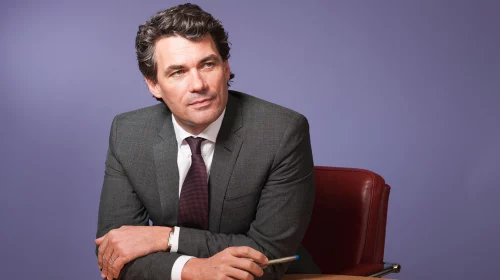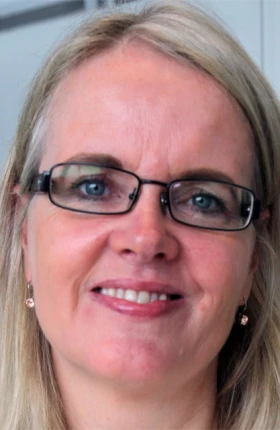Gavin Patterson, an engineer by education, is a marketer by inclination. He began his career 25 years ago at consumer-goods giant Procter & Gamble before finding his way into consumer roles in the cable and telecommunications industries. As CEO of BT Group, the UK-based telecom operator, Patterson has had the chance to put both his educational and professional backgrounds to work.
Patterson, for example, is simultaneously overseeing the rollout of a national high-speed digital network and the creation of a content business built around broadcasting live sports. In his mind, content can transform technology by giving customers a premium broadband experience, while technology can transform content by bringing it to life in creative ways.
Technology, in other words, exists not as an end in itself but as an enabler—a tool to help customers in their personal and professional lives. This view explains BT’s recent reentry into the mobile-telephony market after an absence of more than a decade. Patterson wants BT customers to experience a “completely converged network” in which the distinctions between fixed and mobile services fall away.
Customers are not Patterson’s only focus. He also wants employees to understand and embrace this vision for BT, and he aims for BT to serve as a beacon that attracts great talent so that the next generation can carry on the work of providing better customer experiences through technology.
Patterson recently sat down with Dominic Field, a BCG partner, for a discussion about leadership and convergence. Edited excerpts from that conversation follow.
Gavin, thank you very much for speaking with us. Would you tell us how a marketing executive from P&G ends up running the oldest telco in the world?
I studied engineering at university, so I come from a technical background, but I really wanted to learn how to run a business. I decided on graduating that P&G was the place to learn how to run a business. Then, in the late ’90s, the opportunity came to switch into telecommunications—in fact, switch into cable. It came at the time when P&G was moving its profit centers to Geneva. So it was a fork in the road for me.
Digital technologies are creating huge opportunities for society, for companies, for individuals. Would you give us your thoughts on some of the opportunities and challenges digital has created for society?
One of the fantastic things about digital—and this is something in which BT has been very active—is ensuring that, through our fiber rollout, you can create a business wherever you live in the country. You don’t have to live in a big city. You can run a business from Cornwall, for example. It is a very remote part of the UK, but it has a phenomenal fiber network with 95% coverage. There are all sorts of really interesting businesses coming out of there.
Security and privacy are other key issues. Clearly, this is very topical here in the UK at the moment. People want—and are understandably very protective of—their privacy. But at the same time, they understand that they have responsibilities to ensure that the country is secure. Getting that balance right is one of the challenges that we face.
Would you talk a bit about how digital technology has enabled BT to transform?
One of the challenges is that we’re moving from an analog world into a digital world. A lot of profits are tied up in old technologies, but if you become too dependent on those technologies, you really don’t embrace some of the new ones. I wouldn’t say we are best in class. We do put digital at the forefront of what we do—both in terms of the way we think about our propositions and how we design them—and we also use digital to simplify and automate our business and to take waste out.
With your marketing background, you bring a strong customer perspective to the business. Would you talk a little bit about how you balance the consumer and the technology perspective?
Ultimately, it has to be about the customer, or the consumer as you say. Technology is in many ways meaningless if it isn’t enabling a customer to do something. That can be to live their life better, run their business better, or educate themselves in a different way. So it’s not an end in itself.
At P&G this is almost genetically wired into you. You start with the customer, you end with the customer, and the financials are only the bit in between. We’re making progress at BT, but I know I really won’t have achieved what I want to achieve in this area until it is very much part of the DNA. I’m confident we’ll get there, but we’re not there yet.
BT is noted here in the UK, and perhaps internationally, as being one of the few telcos that successfully made a big bet on content, acquiring the rights to the Premier League. How do you balance the content business with your investments in network infrastructure, which have also been significant? How do you see them working together?
They’re mutually supporting in terms of what they provide for our customers. Our investments in fiber are significant: over £3 billion. We’ll end up providing super-fast coverage to well over 90% of the UK. The investments in sport are a way of providing differentiation to our own service providers, BT Consumer in particular. The reason we made the investment is that we know that sport, and particularly live sport, is one of those things that really moves the dial for a significant group of customers. We felt that the market wasn’t being served by the current choices.
Now you’re getting into mobile in a big way with the acquisition of EE, which is the UK’s leading mobile network. What does that tell us about your vision for the future of communications?
Our vision is one of a completely converged network in which you can’t distinguish between mobile and fixed. You have a single seamless network that is designed around data. That’s what we see in the future.
You have been CEO for two years. How are you spending your time today differently from maybe a year ago?
One of the great challenges as a leader is, amongst the myriad of things that come your way, how do you distinguish what to work on and what not to? How do you distinguish the signal from the noise, if you like? That’s always a challenge, but you learn to trust your instincts more. You learn that not everything that falls into your in-tray is urgent and important, and, over time, you begin to prioritize better and work on the most important things. That’s key.
What is your view of a successful leader?
Ultimately, successful leaders have to be themselves. You have to be able to feel comfortable in who you are and to be able to live in a way that’s very transparent to people. You have to have a clear vision of the future and to be able to articulate and build excitement and support for it. You want people to be inspired. That’s important.
You have to be good at making decisions. You need to get the big ones right, and then the rest of them, you need to make efficiently. You don’t have to get every decision right. That’s important.
Then you have to be able to develop people. Ultimately, great leaders are able to create fantastic teams around themselves and can inspire the next generation. That’s fundamental to creating the sort of organization that certainly I want, and that’s one of the things we’re very much focused on.




